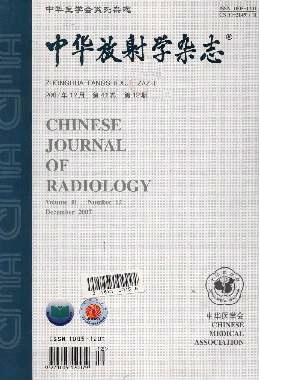Safety and efficacy of balloon pulmonary angioplasty in the treatment of chronic thromboembolic pulmonary hypertension
Q4 Medicine
Zhonghua fang she xue za zhi Chinese journal of radiology
Pub Date : 2020-01-10
DOI:10.3760/CMA.J.ISSN.1005-1201.2020.01.010
引用次数: 0
Abstract
Objective To evaluate the safety and efficacy of balloon pulmonary angioplasty (BPA) in the treatment of chronic thromboembolic pulmonary hypertension (CTEPH). Methods A study was conducted on 25 patients consisting of 10 males and 15 females with CTEPH who received BPA treatment from February 2017 to May 2018 in Beijing Chaoyang Hospital, Capital Medical University. The changes of brain natriuretic peptide (BNP), mean pulmonary artery pressure (mPAP), tricuspid annulus systolic plane excursion (TAPSE), six-minute walking test (6WMD), right ventricular basement diameter and WHO cardiac function grading were compared before and after treatment with BPA using paired t test. Results Twenty-five patients received a total of 50 BPA treatments, and among them, 12 patients received two or more times. The mPAP decreased from (50.4±9.9) mmHg (1 mmHg=0.133 kPa) to (39.9±10.6) mmHg before and after operation, and the difference was statistically significant (t=9.7, P<0.001); BNP decreased from (513.5±357.3) pg/ml to (106.3±137.53) pg/ml, and the difference was significant (t=3.2, P=0.006); TAPSE increased from (16.2±2.8) mm to (18.0±2.4) mm, and the difference was statistically significant (t=-5.7, P=0.002); the right ventricular base diameter decreased from (45.9±6.9) mm to (41.2±7.3) mm, and the difference was statistically significant (t=5.6, P<0.001); 6WMD increased from (371.1±86.8) m to (467.7±76.1) m, with statistical significance (t=-6.4, P<0.001); WHO cardiac function grading was improved from (2.4±0.7) to (1.2±0.4) after surgery, and the difference was statistically significant (t=2.8, P=0.021). Pulmonary artery injury occurred in 3 patients and 2 patients had hemoptysis.The hemoptysis was stopped after arterial embolization. No other complications such as pulmonary edema occurred. Conclusion BPA may improve clinical status and hemodynamics of patients with CTEPH, which offers an alternative approach of treatment in patients with inoperable CTEPH. Key words: Pulmonary embolism; Chronic disease; Hypertension, pulmonary; Angioplasty, balloon; Treatment outcome球囊肺血管成形术治疗慢性血栓栓塞性肺动脉高压的安全性和有效性
目的评价球囊肺血管成形术(BPA)治疗慢性血栓栓塞性肺动脉高压(CTEPH)的安全性和有效性。方法对2017年2月至2018年5月在首都医科大学北京朝阳医院接受BPA治疗的25例CTEPH患者进行研究,其中男性10例,女性15例。用配对t检验比较BPA治疗前后脑钠尿肽(BNP)、平均肺动脉压(mPAP)、三尖瓣环收缩平面偏移(TAPSE)、6分钟步行试验(6WMD)、右室基底径和世界卫生组织心功能分级的变化。结果25例患者共接受了50次BPA治疗,其中12例患者接受了两次或两次以上BPA治疗。mPAP由术前(50.4±9.9)mmHg(1mmHg=0.133kPa)降至术后(39.9±10.6)mmHg,差异有统计学意义(t=9.7,P<0.001);BNP从(513.5±357.3)pg/ml降至(106.3±137.53)pg/ml,差异有统计学意义(t=3.2,P=0.006);TAPSE从(16.2±2.8)mm增加到(18.0±2.4)mm,差异有统计学意义(t=-5.7,P=0.002);右心室基底径由(45.9±6.9)mm降至(41.2±7.3)mm,差异有统计学意义(t=5.6,P<0.001);6WMD从(371.1±86.8)m增加到(467.7±76.1)m,具有统计学意义(t=-6.4,P<0.001);术后世界卫生组织心功能分级由(2.4±0.7)提高到(1.2±0.4),差异有统计学意义(t=2.8,P=0.021),肺动脉损伤3例,咳血2例。动脉栓塞后止血。没有出现肺水肿等其他并发症。结论BPA可改善CTEPH患者的临床状态和血流动力学,为不能手术的CTEPH提供了一种替代治疗方法。关键词:肺栓塞;慢性病;高血压,肺部;血管成形术,球囊;治疗结果
本文章由计算机程序翻译,如有差异,请以英文原文为准。
求助全文
约1分钟内获得全文
求助全文
来源期刊

Zhonghua fang she xue za zhi Chinese journal of radiology
Medicine-Radiology, Nuclear Medicine and Imaging
CiteScore
0.30
自引率
0.00%
发文量
10639
 求助内容:
求助内容: 应助结果提醒方式:
应助结果提醒方式:


